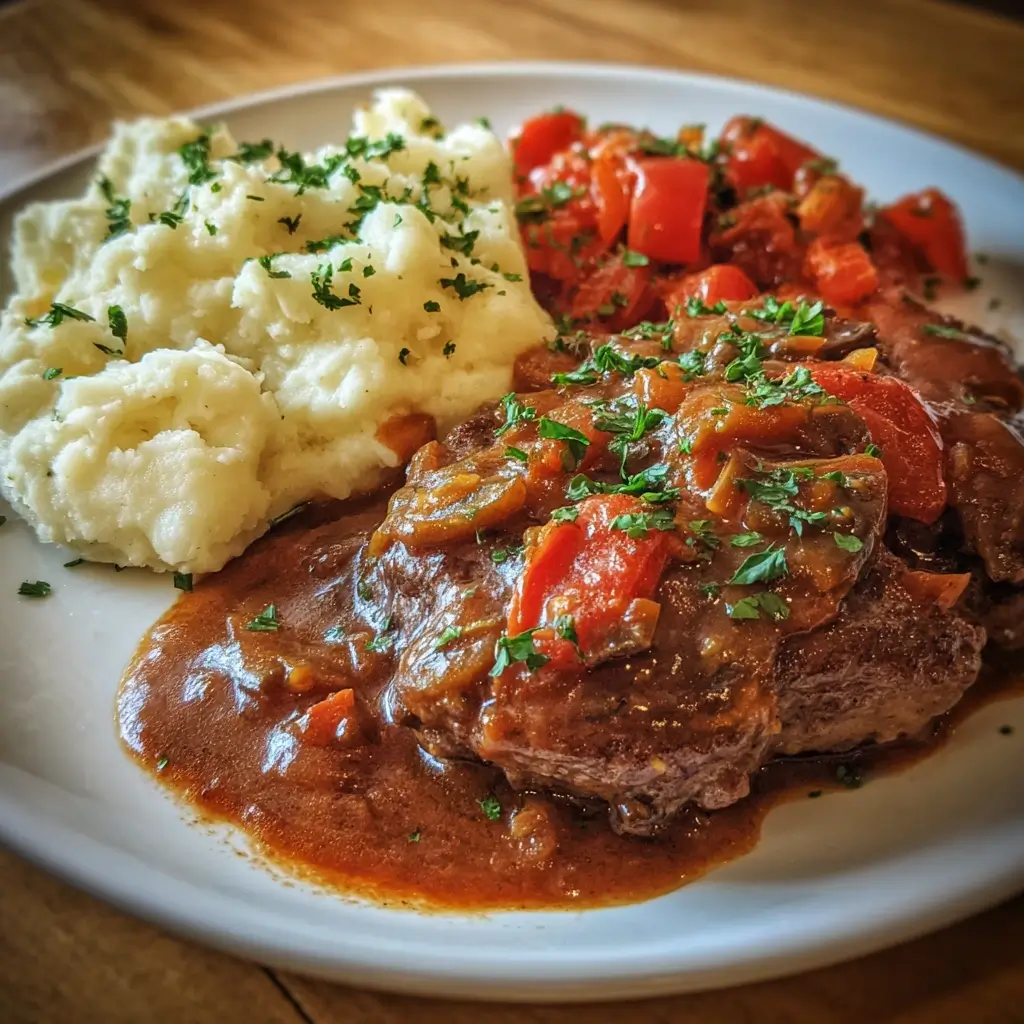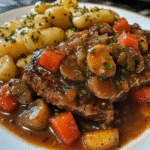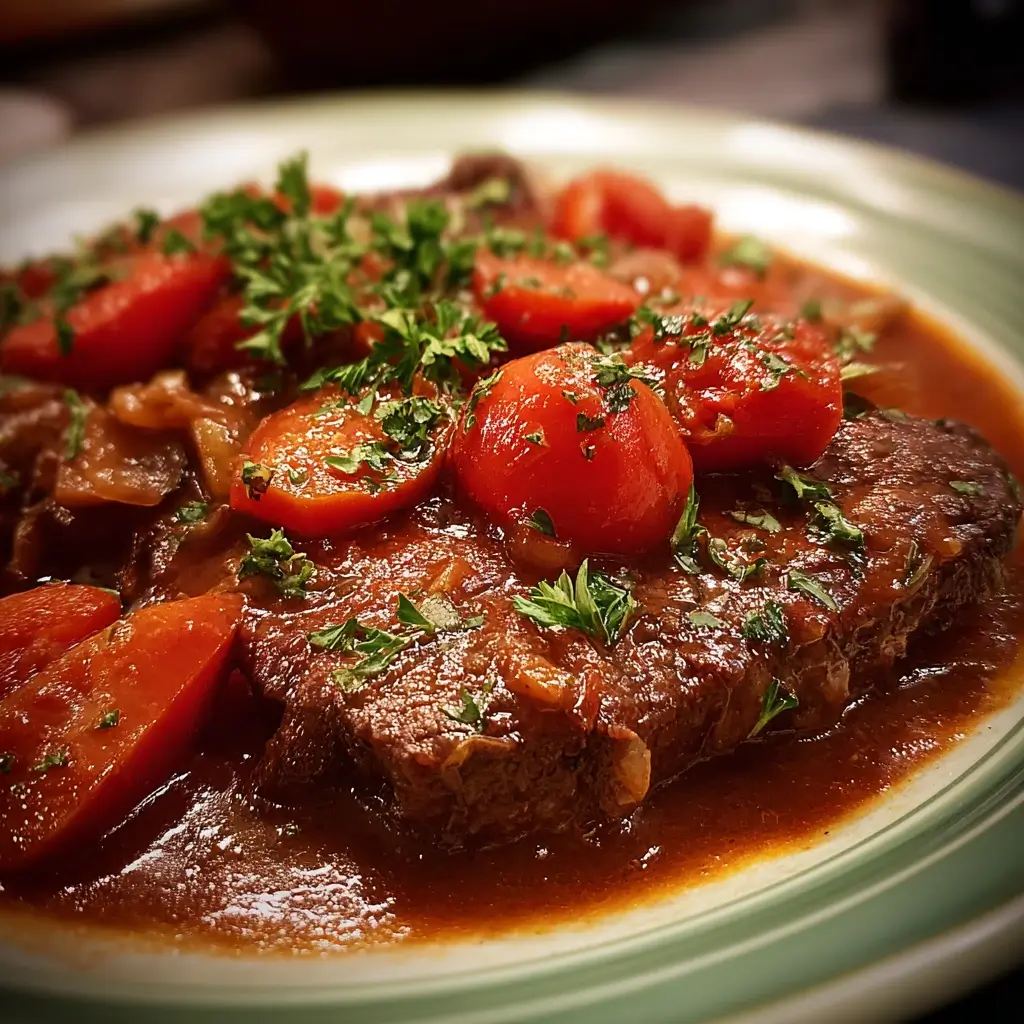Old fashioned Swiss steak holds a special place in my culinary heart, reminding me of the transformative power of simple, honest cooking. As Michael from FoodyDish, I’ve spent years perfecting traditional recipes that bring families together around the dinner table, and this Swiss steak recipe represents everything I love about comfort food done right.
Picture this: you’re staring at a tough cut of round steak, wondering how to turn this affordable protein into something truly memorable. That’s exactly where I found myself years ago when developing this recipe. Through careful technique and patience, this old-fashioned Swiss steak transforms from a humble piece of meat into fork-tender perfection, swimming in a rich, savory tomato-based sauce that’ll have your family asking for seconds.
Having experimented with countless variations over my culinary journey, I’ve discovered the secret lies in the slow braising process and proper meat preparation. This recipe delivers restaurant-quality results using ingredients you likely already have in your pantry, making it perfect for both weeknight dinners and special family gatherings.
In this comprehensive guide, I’ll walk you through selecting the perfect cut of meat, mastering the braising technique, exploring delicious variations, and answering all your burning questions about creating the perfect Swiss steak every time.
Why This Old-Fashioned Swiss Steak Recipe Works
This old-fashioned Swiss steak recipe succeeds where others fail because it embraces the fundamental principles of slow cooking and proper meat preparation. Here’s what makes this recipe a winner:
• Uses affordable, accessible cuts – Round steak transforms from tough to tender through our proven braising method • Simple pantry ingredients create complex flavors – Basic vegetables and seasonings develop into a rich, satisfying sauce • Flexible cooking timeline – Perfect for busy weeknights or leisurely weekend cooking sessions • One-pot convenience – Everything cooks together, minimizing cleanup while maximizing flavor • Feeds a crowd affordably – Stretches 2 pounds of meat to serve 6-8 people generously
The magic happens during the long, slow simmer, where tough connective tissues break down into gelatin, creating that signature melt-in-your-mouth texture that defines perfect Swiss steak.
Choosing the Right Meat for Old-Fashioned Swiss Steak
Success with Swiss steak begins at the butcher counter. Understanding meat selection will elevate your results dramatically.
Best Cuts for This Old-Fashioned Swiss Steak Recipe
Round steak remains the traditional choice for good reason. This lean cut from the rear leg contains enough connective tissue to become incredibly tender when braised properly. Look for pieces cut ½ to ¾ inch thick for optimal cooking results.
Alternative cuts that work beautifully:
- Chuck steak – More marbled than round, creating richer flavor
- Bottom round – Leaner option that still tenderizes well
- Eye of round – Budget-friendly choice requiring slightly longer cooking time
Buying Tips for Perfect Swiss Steak
When selecting your meat, look for bright red color without gray or brown spots. The meat should feel firm to the touch and have minimal liquid in the package. Don’t shy away from visible connective tissue – this white marbling will transform into tender, flavorful gelatin during cooking.
Ask your butcher to run the steak through the cubing machine once if available. This mechanical tenderizing process creates tiny cuts in the muscle fibers, reducing cooking time while ensuring tenderness.
Smart Substitutions for Old-Fashioned Swiss Steak
Can’t find round steak? Cube steak works as a direct substitute, though reduce cooking time by 30 minutes since it’s pre-tenderized. Stew meat can replace steak entirely – just increase cooking time to 2.5-3 hours for proper tenderness.
Ingredients & Prep for Old-Fashioned Swiss Steak
Proper preparation sets the foundation for exceptional Swiss steak. Let’s break down each component and preparation technique.
Complete Ingredient List for Old-Fashioned Swiss Steak
For the Meat:
- 1 ½ to 2 lbs round steak (about ½ inch thick), trimmed
- ½ cup all-purpose flour
- 1 tsp salt
- ½ tsp black pepper
- 2–3 tbsp vegetable oil
For the Sauce & Vegetables:
- 1 large onion, thinly sliced
- 1 green bell pepper, sliced (optional)
- 2 garlic cloves, minced
- 1 (14.5 oz) can diced tomatoes (undrained)
- 1 cup beef broth
- 1 tbsp tomato paste (optional for richer sauce)
- 1 tsp Worcestershire sauce
- ½ tsp paprika
- 1 bay leaf (optional)
Meat Prep Essentials for Swiss Steak Success
Tenderizing technique: Pound your round steak lightly with a meat mallet, working from center outward. This breaks down tough muscle fibers and creates uniform thickness for even cooking. Don’t over-pound – you want texture, not mush.
Dredging process: The flour coating isn’t just for browning – it helps thicken your final sauce naturally. Season your flour mixture generously with salt and pepper, ensuring every piece gets thoroughly coated.
Temperature matters: Allow meat to come to room temperature for 30 minutes before cooking. Cold meat hits hot oil and seizes up, becoming tough and chewy.
Building Flavor Layers in Your Swiss Steak
Aromatics foundation: Yellow onions provide the best balance of sweetness and pungency. Slice thin for faster cooking and better integration into the sauce. Green bell peppers add color and mild vegetable sweetness.
Liquid components: Canned diced tomatoes provide acidity that helps break down tough fibers. Beef broth adds depth – use low-sodium varieties to control salt levels. The combination creates that signature Swiss steak sauce.
Seasoning symphony: Worcestershire sauce contributes umami depth, while paprika adds subtle smokiness and beautiful color. The bay leaf infuses earthy, almost tea-like notes during the long simmer.
Pantry Staples for Old-Fashioned Swiss Steak
Keep these essentials stocked for spontaneous Swiss steak success:
- All-purpose flour for dredging and sauce thickening
- Quality vegetable oil with high smoke point for proper browning
- Canned tomatoes – diced works best for texture
- Beef broth – homemade preferred, but quality store-bought works
- Basic seasonings – salt, pepper, paprika, bay leaves
Step-by-Step Cooking Instructions for Old-Fashioned Swiss Steak
Follow these detailed steps for guaranteed Swiss steak success every time.
Pre-Cooking Prep for Perfect Swiss Steak
Step 1: Pat round steak completely dry with paper towels. Any surface moisture prevents proper browning and creates steam instead of the flavorful crust we want.
Step 2: Pound meat lightly with tenderizing mallet, then season generously with salt and pepper. Let sit 15 minutes while preparing other ingredients.
Step 3: Set up dredging station with seasoned flour in shallow dish. Heat Dutch oven or heavy skillet over medium-high heat with vegetable oil.
Cooking Method for Old-Fashioned Swiss Steak Mastery
Browning phase: Dredge each piece thoroughly in seasoned flour, shaking off excess. Brown steak pieces 2-3 minutes per side until deep golden brown. Don’t overcrowd – work in batches for best results. Remove and set aside.
Building the sauce: In same pan with flavorful browned bits, sauté sliced onions and bell peppers until softened, about 4 minutes. Add minced garlic for final 30 seconds – longer cooking makes garlic bitter.
Deglazing magic: Add diced tomatoes with juice, scraping up those precious browned bits. Stir in beef broth, tomato paste, Worcestershire sauce, paprika, and bay leaf. Return browned steak to pan, nestling into sauce.
Doneness Check for Old-Fashioned Swiss Steak
Unlike quick-cooking steaks, Swiss steak relies on time rather than temperature for doneness. After 1.5 hours of gentle simmering, test with a fork – properly cooked Swiss steak should fall apart easily with minimal pressure.
Visual cues: Sauce should be thickened and rich, coating the back of a spoon. Meat fibers should be visibly tender, almost shredding when stirred.
Resting Your Old-Fashioned Swiss Steak
Allow Swiss steak to rest off heat for 10 minutes before serving. This lets the sauce settle and flavors meld completely. Remove bay leaf before serving – nobody wants to bite into that surprise!
Pro Tips for Perfect Old-Fashioned Swiss Steak
These insider secrets separate good Swiss steak from great Swiss steak.
Avoiding Tough, Dry Swiss Steak
Don’t rush the process: Swiss steak cannot be hurried. Low, slow cooking is essential for breaking down tough connective tissues. High heat creates tough, chewy results.
Monitor liquid levels: Check every 30 minutes during cooking. Add warm beef broth if sauce reduces too much – cold liquid shocks the meat and slows cooking.
Proper pan selection: Heavy-bottomed Dutch oven or cast-iron skillet distributes heat evenly, preventing hot spots that can burn your sauce.
Essential Tool Recommendations for Swiss Steak Success
Meat mallet: Mechanical tenderizing speeds cooking and improves texture significantly.
Cast-iron Dutch oven: Superior heat retention and distribution for even braising.
Wooden spoon: Won’t scratch your cookware while stirring and scraping up browned bits.
Storage & Reheating Your Old-Fashioned Swiss Steak
Refrigerator storage: Swiss steak improves with time. Store covered up to 4 days flavors continue developing.
Freezing tips: Freeze in sauce up to 3 months. Thaw overnight in refrigerator before reheating.
Reheating method: Low heat on stovetop with splash of beef broth prevents drying out. Microwave works but may create tough spots.
Flavor Variations for Old-Fashioned Swiss Steak
Transform your basic Swiss steak into exciting new experiences with these tested variations.
Spicy Southwest Swiss Steak Twist
Add diced jalapeños with the onions and bell peppers. Include 1 teaspoon ground cumin and ½ teaspoon chipotle powder in your flour mixture. Finish with fresh cilantro and serve with warm tortillas for Swiss steak tacos.
Mediterranean Old-Fashioned Swiss Steak
Replace beef broth with red wine for deeper flavor. Add sliced mushrooms, fresh thyme, and a splash of balsamic vinegar. Serve over creamy polenta instead of traditional sides.
Asian-Inspired Swiss Steak Variation
| Component | Traditional | Asian Variation |
|---|---|---|
| Liquid Base | Beef broth + tomatoes | Beef broth + soy sauce |
| Aromatics | Onions + bell peppers | Onions + mushrooms + ginger |
| Seasonings | Worcestershire + paprika | Rice wine + five-spice |
| Garnish | Fresh parsley | Green onions + sesame seeds |
| Serving | Mashed potatoes | Steamed rice + bok choy |
Keto-Friendly Swiss Steak Adaptation
Skip the flour dredging – brown meat directly for lower carbs. Replace diced tomatoes with sugar-free marinara sauce. Serve over cauliflower mash or zucchini noodles instead of traditional starches.
Serving Suggestions for Old-Fashioned Swiss Steak

The right accompaniments elevate Swiss steak from simple comfort food to memorable dining experience.
Classic pairings: Creamy mashed potatoes absorb that beautiful sauce perfectly. Buttered egg noodles provide neutral backdrop for bold flavors. Simple white rice works wonderfully for lighter option.
Vegetable sides: Roasted root vegetables complement the hearty nature of Swiss steak. Green beans with almonds add fresh crunch. Sautéed spinach with garlic provides nutritional balance.
Bread options: Crusty French bread for sauce sopping. Buttermilk biscuits for true Southern comfort. Dinner rolls for family-style serving.
Beverage pairings: Full-bodied red wines like Cabernet Sauvignon or Merlot match the rich flavors. For beer lovers, try robust porters or brown ales. Non-alcoholic options include iced tea or sparkling water with lemon.
FAQs About Old-Fashioned Swiss Steak
Can I use frozen meat for Swiss steak?
Yes, but thaw completely first. Partially frozen meat cooks unevenly and won’t brown properly. Plan extra thawing time – round steak takes 12-24 hours in refrigerator depending on thickness.
How do I fix overcooked Swiss steak?
If your Swiss steak becomes dry, add warm beef broth gradually while stirring gently. Reduce heat and continue cooking until moisture is absorbed. Next time, check doneness earlier and maintain lower heat.
Is this Swiss steak recipe safe during pregnancy?
Absolutely! Swiss steak cooks to well-done temperatures, eliminating any food safety concerns. The long braising process ensures meat reaches safe internal temperatures throughout.
Can I make Swiss steak in a slow cooker?
Yes! Brown meat and vegetables first, then transfer to slow cooker with liquids. Cook on LOW 6-8 hours or HIGH 3-4 hours. The texture won’t be identical to stovetop version but remains delicious.
What’s the difference between Swiss steak and country-fried steak?
Swiss steak is braised in liquid until tender, while country-fried steak is breaded and pan-fried, then served with gravy. Swiss steak uses tougher cuts that benefit from long, slow cooking.
Can I make this recipe dairy-free?
This Swiss steak recipe is naturally dairy-free! Just ensure your beef broth doesn’t contain any dairy ingredients – some commercial broths do.
Conclusion
This old-fashioned Swiss steak recipe represents everything I love about transformative cooking – taking humble ingredients and creating something truly special through technique and patience. The reward for your time investment is fork-tender meat swimming in rich, flavorful sauce that brings families together around the dinner table.
Fire up your Dutch oven and try this tonight! Start with quality round steak, embrace the slow braising process, and watch as tough meat transforms into comfort food gold. Don’t forget to share your results with our FoodyDish community – we love seeing your culinary successes!
Happy cooking, and remember – great food brings people together, one delicious bite at a time.
If you loved this recipe, don’t forget to share it with your friends or save it to try later!
I’d be thrilled to see your personal touch—share your photos on Pinterest
Print
Old-Fashioned Swiss Steak: A Timeless Comfort Food Classic
- Total Time: 2 hours 15 minutes
- Yield: 4 servings 1x
Description
Old-Fashioned Swiss Steak is fork-tender beef simmered in a savory tomato-onion gravy. It’s the definition of comfort—rich, rustic, and slow-cooked to perfection.
Ingredients
2 lbs beef round steak, ½-inch thick, trimmed and cut into 4 portions
½ cup all-purpose flour
1½ teaspoons salt
½ teaspoon black pepper
2 tablespoons vegetable oil
1 large onion, thinly sliced
1 green bell pepper, sliced (optional)
2 cloves garlic, minced
1 can (14.5 oz) diced tomatoes with juice
1 cup beef broth
1 tablespoon Worcestershire sauce
1 teaspoon paprika
Instructions
1. In a shallow dish, combine flour, salt, and pepper. Dredge each piece of steak, pressing to coat.
2. In a large skillet or Dutch oven, heat oil over medium-high heat. Brown the steak in batches, 2–3 minutes per side. Set aside.
3. Add onions and bell peppers to the skillet. Sauté for 3–4 minutes until softened. Stir in garlic and cook 30 seconds.
4. Add diced tomatoes, beef broth, Worcestershire sauce, and paprika. Stir to combine and bring to a simmer.
5. Return steak to the pan, nestling into the sauce. Cover, reduce heat to low, and simmer for 1½ to 2 hours until the meat is fork-tender.
6. Serve with mashed potatoes, rice, or egg noodles.
Notes
For deeper flavor, add a splash of red wine to the sauce.
This dish reheats well and tastes even better the next day.
Use a heavy-lidded pot or Dutch oven for even, gentle simmering.
- Prep Time: 15 minutes
- Cook Time: 2 hours
- Category: Main Course
- Method: Stovetop Braise
- Cuisine: American
Nutrition
- Serving Size: 1 steak with sauce
- Calories: 460
- Sugar: 6g
- Sodium: 580mg
- Fat: 24g
- Saturated Fat: 8g
- Unsaturated Fat: 13g
- Trans Fat: 0g
- Carbohydrates: 14g
- Fiber: 2g
- Protein: 42g
- Cholesterol: 120mg
Keywords: swiss steak recipe, classic beef dinner, old-fashioned comfort food

